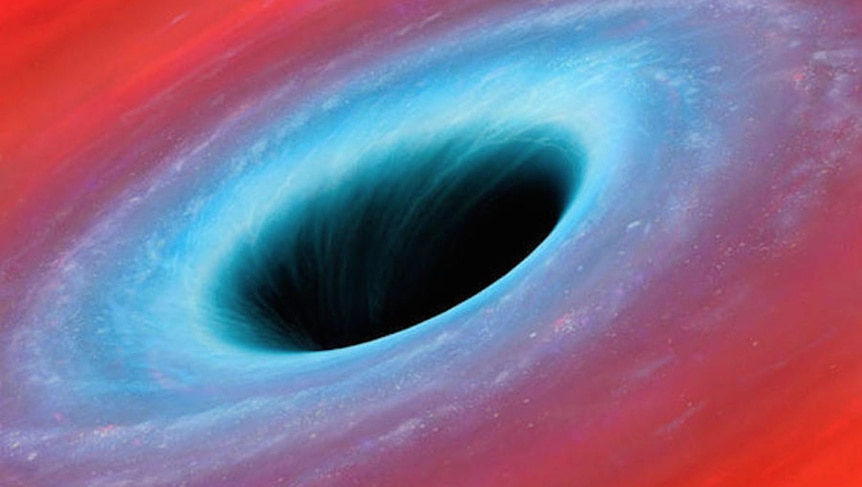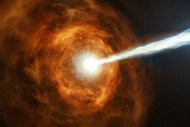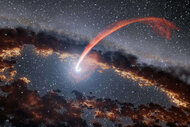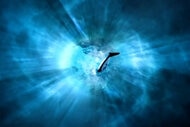Create a free profile to get unlimited access to exclusive videos, sweepstakes, and more!
It's Not the Closest Black Hole to Earth, But the Biggest Stellar Mass Black Hole Ever Found Ain't Far
Only one black hole is closer to Earth.
Director John Carpenter’s first feature-length film, Dark Star, features a bizarre cast of astronauts, a sentient spaceship, and a bomb struggling with a personal existential crisis, all on a mission to destroy unstable planets. It takes its name from the original moniker for what would become known as black holes. In 1783, scientist and theologian John Michell cooked up the idea for what he called dark stars, stars with such immense gravitational power that they jealously hold onto everything they touch, even light.
Later, over the next two centuries, scientists including the likes of Albert Einstein, Karl Schwarzschild, and J. Robert Oppenheimer built upon the idea of dark stars until, finally, one was detected. In 1971, astronomers confirmed the existence of the black hole Cygnus X-1. It lies about 6,000 light-years from here and has a mass about 20 times that of the Sun.
Today, we know that supermassive black holes polka dot the cosmos, and there may be as many as 100 million less-massive black holes in our galaxy, alone. Recently, astronomers discovered one of them hiding out close by, and it's the biggest of its kind that we’ve ever seen.
For More on Black Holes:
How the Vera Rubin Observatory Will Hunt Down Black Holes
How Worried Should We Be About Black Holes? Separating Fact from Fiction
Did J. Robert Oppenheimer Discover Black Holes? Sort of, But Not By Himself
Supermassive Black Holes vs Stellar Mass Black Holes
Black holes are incredible collections of tightly packed matter. They have more material than the Sun all smashed into a single infinitely dense point. In the vicinity of a black hole, spacetime becomes so warped that anything which falls inside the gravity well can never escape. Get too close and the universe will punch your one-way ticket to nowheresville. That’s not to say that all black holes are the same. They vary in terms of their mass and the scope of the gravity well they produce.
The biggest of them, the cosmic rulers of annihilation, are the supermassive black holes. They are the superstars of the universe, the gravitational fulcrums upon which galaxies are balanced. Almost all large galaxies, including our own, have a supermassive black hole at their centers. The black hole at the center of the Milky Way, Sagittarius A* (Sag A*), has the mass of 4.2 million Suns, give or take a few thousand stars.
Astronomers believe that supermassive black holes form through the merger of many smaller black holes over long stretches of time. They may also have gotten a boost from the deaths of monster stars during the early days of the universe. Supermassive black holes are the easiest to find for a couple of reasons. First, we know where to look. Second, they tend to have disks of hot material swirling around them, just outside the event horizon. While we can’t see black holes themselves, we can see their charged plasmatic entourage running laps around them.
The larger population of black holes is made up almost entirely of stellar mass black holes, singularities with masses on par with stars. They are born from stars with masses about 20 times that of the Sun or more. When they run out of fuel to fuse in their cores, they explode in a violent supernova before collapsing into a black hole. What’s left behind is a light-gobbling singularity with a mass a few times (or a few hundred times) that of the Sun.
The Closest Known Black Hole to Earth
In 2002, astronomers using data from the ESA’s space-based Gaia observatory found evidence of a black hole 1,561 light-years from here. It’s not especially big, only about 10 times the mass of the Sun, but it’s the closest bottomless pit we know of. The black hole, dubbed Gaia BH1, was identified because Gaia is particularly good at measuring the movements of stars. It images the sky over and over, comparing the position and motion of stars over time. By watching the way stars slide across the night sky, astronomers can figure out if they have a dancing partner, like an exoplanet or a black hole.
Now, astronomers have identified another black hole from Gaia data, the slightly more distant but much more massive Gaia BH3. At a distance of just under 2,000 light-years and in the direction of the constellation Aquila, BH3 is the second-closest black hole ever discovered. It comes in second for distance but gets the top spot for girth in the stellar mass black hole weight division. BH3 is the most massive stellar mass black hole we’ve ever seen, with the equivalent of 33 Suns stuffed inside it. That’s about 50% more massive than the next-largest stellar mass black hole, Cygnus X-1.
“No one was expecting to find a high-mass black hole lurking nearby, undetected so far. This is the kind of discovery you make once in your research life,” said Gaia collaboration member Pasquale Panuzzo, in a statement."
BH3 and its companion star orbit relatively close to one another. If we put the black hole where the Sun is, then its companion star would orbit at a distance between that of Jupiter and Neptune as it dips closer and farther away along its elliptical orbit. They’re not close enough for BH3 to snatch bits of star, but it’s close enough for astronomers to see the star wobbling in response.
Gaia BH3 is a dormant black hole, meaning it’s not currently sucking up matter, so we couldn’t see it from its accretion disk. Instead, astronomers found it by watching the wobble of its companion star. After the detection, astronomers calculated its mass using telescopes on the ground. Because binary stars are often made of the same stuff, future studies of the companion could reveal insight into the black hole’s origin story.
In fact, astronomers have already determined that the companion star is relatively low in elements heavier than hydrogen or helium. That means it has what astronomers call low metallicity, which might help explain how the black hole formed. Astronomers have hypothesized that stars with low metallicity lose less mass over their lifetimes, leaving more mass at the end for crushing into a pinpoint. The existence of Gaia BH3 supports that hypothesis and helps to explain how large stellar mass black holes form.
Watch Dark Star streaming now on Peacock!




















